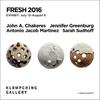MACAAL's 'Material Insanity' Group Show Explores Timely Themes in Art Using Everyday Objects---from Toothbrushes to Acrylic Nails
- MARRAKECH, Morocco
- /
- February 21, 2019
The Museum of African Contemporary Art Al Maaden (MACAAL), Marrakech, will present Material Insanity, a group show exploring the material and its symbolic significance in a plurality of dimensions and formal experiences.
Opening on 26 February 2019, the exhibition contains works by 34 artists including Hassan Hajjaj (Morocco), Ibrahim Mahama (Ghana), Frances Goodman (South Africa) and Nari Ward (Jamaica), working across varying mediums. Through installations made from everyday objects, including new site-specific pieces commissioned by MACAAL, the exhibition reveals how artists from the African continent and its diaspora relate or reimagine biographies of objects and materials to reflect the social, political, or economic contexts of their lived experience.
The exhibition also invites a critical analysis of past and present society by considering the impact of materiality on the world and its future, and by offering itself as a cultural response to devaluation, and dematerilisation, in an increasingly digital era.
Responding to current art movements which focus on the transient or intangible, works such as Clay Apenouvon’s (Togo - France) stretched black plastic film, Owanto’s (Gabon) embroideries exhumed from the collective memory and Cyrus Kabiru’s (Kenya) material reinvention of electronic waste in the form of sculptural eyewear, question the lasting effects of globalization and consumerism in the comtemporary climate. Reinvisioning materials often associated with trade and waste as artworks, artists including Nari Ward (Jamaica), Beya Gille Gacha (Cameroon – France), Fatiha Zemmouri (Morocco), M’barek
Bouhchichi (Morocco), Hassan Bourkia (Morocco) and Malek Gnaoui (Tunisia), diversely use materiality as representations of memory, migration, societal expectations and tradition. Through their selected media they expose traces of many individual journeys and histories, illuminating the multiplicity of stories within the contemporary climate.
The immersive scenography of architect and artist Zineb Andress Arraki provides a space through which the exhibition’s concerns are amplified. These scenographic elements stretch from the Museum’s entrance to the garden; at the ground floor, monoliths and freestanding walls refer to sequentiality, perspective and the juxtaposition of spaces. The upper level follows a similar design, with mirrored sections accentuating the unity of the spectator’s space and the space of the artwork.
Several of the artists have created immersive works which draw the viewer in by their senses. A new work, DO touch and smell by Esmerelda Kosmatopoulos questions the physical connections that exist between the viewer and the artwork in an exhibition setting.
For Material Insanity, Hassan Hajjaj has created Le Salon, an immersive site-specific installation inspired by traditional living spaces in Morocco. Le Salon invites the visitors into a domestic setting, where people can interact with each other and with their environment.
The exhibition is curated by Meriem Berrada, Artistic Director at MACAAL & Head of Cultural Projects at Fondation Alliances & Janine Gaëlle Dieudji, Exhibitions Director at MACAAL.
"The works that form Material Insanity go far beyond the renaissance of waste plastics or agro-food industry scraps as artistic objects; they become powerful visual metaphors which tackle topics such as social domination in M’barek Bouhchichi conceptual research, migratory movements of Mahama’s and reinterpreting ancestral craft in visual artwork like Amina Agueznay,’’ says Meriem Berrada.
MACAAL’s garden plays host to Nicolas Henry’s installation Wasteland, a mixed media work made of second hand classical picture frames – elaborately carved and gilded from MACAAL’s construction scraps.
Alongside Material Insanity, MACAAL presents several satellite initiatives including People of Tamba, an open air public art installation of 2x3m photographic prints pasted on the walls of the Marrakech Medina. The photography project aims to create a typological catalogue of the society of Tambacounda, the largest city in the most internal and rural region of Senegal and the point of departure for the majority of Senegalese clandestine migrants. The project has been realised with the support of The Josef and Anni Albers Foundation / Le Korsa / Marock’Jeunes Association.
Projects continue within the Museum space itself, with a pop up store created in conjunction with Limiditi- Temporary art projects. MACAAL aims to use their selection of artist made products to raise questions about the cost of artworks and accessibility.
















